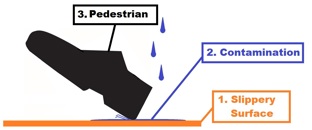Measuring Slip Resistance
People generally slip on wet surfaces or wet shoes, not clean dry surfaces
Consider specification of a wet Pendulum Test Value (PTV) of 36+ in final use conditions
To assess the slip resistance required, complete a slip risk assessment considering future risks including Contamination, Pedestrians, Surface and Other slip factors
|
In 2013, 29% of 969 HSA workplace visits found the risk assessment identified a pedestrian surface where slip resistance testing was required |
Regulation 9 of the General Application Regulations says that floors should be not slippery
Measuring slip-resistance can be an important part of Slip Risk Assessment and Prevention
Slip resistance tests and pedestrian surface treatments are available from private companies in Ireland
It is important that relevant information is sought when specifying flooring, ideally wet Pendulum Test Values (PTV's). There are several types of slip resistance tests including coefficient of friction tests, surface micro-roughness tests and ramp tests.
Coefficient of friction tests
Coefficient of Friction (CoF) tests include the pendulum test (HSE UK's preferred test method) and Slip Alert. Both measure the dynamic coefficient of friction. Other friction tests are available.
For specification or legal action, a robust test, such as the pendulum, should be used.
The Slip Alert, operated correctly, produces valid results and is useful for risk assessment and monitoring surfaces.
The pendulum test mimics the way a heel makes contact with a floor and is HSE UK's preferred test method. In this video (6 min 7 sec), Steve Thorpe from HSL demonstrates pendulum slip resistance results of a dry floor, a wet floor and a “cleaned” floor.
Advice on slip potential results for straight walking on a horizontal surface is shown below

- The Slip Potential PTV ranges are for both 4S (shod) and TRL (barefoot) sliders in Assessment of floor slip resistance for straight walking on a horizontal surface
- PTV slip probabilities if straight walking on a horizontal surface are
-
- PTV of 20 indicates a 1 in 2 probability of a slip
- PTV of 24 indicates a 1 in 20 probability of a slip
- PTV of 27 indicates a 1 in 200 probability of a slip
- PTV of 36 indicates a 1 in 1 million probability of a slip
-
- Equivalent STV ranges are provided by SlipAlert. Some “SlipAlert RESULTS GRAPH” illustrations show a larger medium risk zone range from 130 to 173 (instead of 136 to 158 as indicated in Assessment of floor slip resistance)
- Higher PTV's may be required if walking on a non-level surface, a surface where pedestrians turn or otherwise higher risk surface, for examples, stairs, swimming pools, sporting areas
Wet tests should be conducted - people slip on wet surfaces or wet shoes
Surface micro-roughness tests
For a low slip potential a surface needs to have enough micro-roughness to break through a contaminant and make solid-to-solid contact with the pedestrian's heel. The thicker the contaminant, the rougher the floor needs to be to have a low slip potential. Measurements are made in dry conditions but clearly indicate how a surface will perform when wet.
Ramp tests
Different ramp tests exist (including DIN 51130, DIN 51097 (barefoot), BS 4592) and the data from each is presented differently. Because of this, it is important to interpret the data correctly. It is important to choose a test relevant to how the surface will be used and to interpret the data correctly or the data could be highly misleading.
Barefoot Floors Classification
With DIN 51097 ramp testing, barefoot floors can be classified as "Class A" (suitable for barefoot walkways, mainly dry), "Class B" (suitable for showers, pool surrounds) or "Class C" (suitable for steps into water, walk-through pools). It's important to check slip resistance in use, for example, with a coefficient of friction test
R-Rating of Floors
In relation to r-rating of floors for shod slip resistance, it's very important to note that there are no R1 to R8 values and that R9 floors may have the highest shod slip risk.
The HSE UK Assessing the slip resistance of flooring advises that floors classified as “R9 (or in some instances R10) will be slippery when used in wet or greasy conditions. Further problems may arise from the wide range of CoF within a given classification, for example R10 covers a CoF range from 0.18 to 0.34, which represents a very wide range of slip potential.”
R-ratings relate to laboratory tests and may not reflect the actual slip resistance in the real world. However, the actual slip resistance can be tested in place, for example, with a coefficient of friction test

